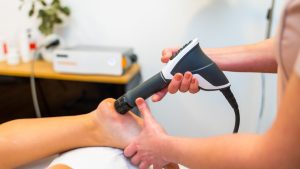Hypermobility refers to a condition where a person’s joints can move beyond the typical range of motion. While people often associate hypermobility with flexibility, many hypermobile people struggle with stiffness and other unexpected symptoms. In this blog post, we’ll explore what hypermobility is, whether you can be hypermobile without being particularly flexible, and whether the condition worsens with age
What is Hypermobility?
Hypermobility is when a person’s joints can extend beyond the normal range of movement. When it is throughout the whole body and not due to an injury, it is often hereditary and is caused by changes in connective tissue that cause it to be more lax. This means that individuals with hypermobility often have a greater range of motion in their joints compared to the general population.
While hypermobility can be a natural and harmless trait for some, in other cases, it may lead to discomfort or pain due to joint instability. In more severe cases, hypermobility can be part of a condition known as Hypermobility Spectrum Disorder (HSD) or Ehlers-Danlos Syndrome (EDS), both of which involve connective tissue abnormalities that can cause issues like joint dislocations, chronic pain, and skin that is more prone to bruising. Connective tissue is everywhere in the body so these symptoms can be widespread. Some of these symptoms can include fatigue and circulatory issues. There are also other syndromes which are connected to hypermobility such as dysautonomias (problems with regulating normally automatic functions i.e. heart rate, blood pressure) and mast cell activation syndrome (MCAS).
Can You Be Hypermobile and Not Flexible?
Yes, it is entirely possible to be hypermobile without being particularly flexible. Many people associate hypermobility with flexibility because both involve a larger range of motion. However, hypermobility can lead to joint instability and discomfort. In some cases, hypermobile people may have tight muscles to compensate for the laxity in their joints, which could limit their overall flexibility despite their hypermobile joints.
Muscle stiffness, tightness and pain are one of the most common complaints we see with hypermobility!
Does Hypermobility Get Worse with Age?
The impact of hypermobility can vary with age, and for some individuals, the condition may seem to worsen as they get older. While hypermobility itself doesn’t necessarily worsen, the way it affects the body can change over time. As people age, the body undergoes changes in tissue elasticity and muscle strength, which can impact how hypermobility manifests.
For some, age comes with joint stiffness which can offer more joint stability. In others, joint stability may become more challenging as they age, leading to more frequent joint dislocations, pain, or discomfort. In addition, repetitive joint stress or injury over time can exacerbate symptoms. Aging may also lead to other age-related conditions, such as arthritis, which can make managing hypermobility more complex.
One significant concern for people with hypermobility is the increased risk of developing early osteoarthritis. Studies have shown that individuals with hypermobility, especially those with Hypermobility Spectrum Disorder (HSD), are at a higher risk of developing osteoarthritis at a younger age. This is due to the increased wear on the joints caused by instability and abnormal motion patterns. The joints in hypermobile individuals are often subjected to more strain, which can lead to cartilage breakdown and the early onset of osteoarthritis.
A study published in the Journal of Rheumatology found that people with joint hypermobility were more likely to experience early-onset osteoarthritis, particularly in weight-bearing joints like the knees and hips. This is because the instability in these joints leads to uneven distribution of forces, increasing the likelihood of cartilage damage (Buchbinder et al., 2015).
However, not all individuals with hypermobility will develop osteoarthritis. Proper management through strengthening exercises, stability training, and joint protection strategies can help reduce the risk of early joint degeneration.
If you suspect you are hypermobile or experience discomfort from hypermobility, we recommend booking an appointment with a specialist MSK physiotherapist or your GP. Visit our specialist hypermobility unit to speak with a highly experienced hypermobility specialist.
Sources:
- Buchbinder, R., Johnston, R. V., & Osborne, R. H. (2015). “Hypermobility and Osteoarthritis: Evidence from Clinical and Experimental Studies.” Journal of Rheumatology.
- Hypermobility Spectrum Disorders: Clinical Features and Management – The Journal of Clinical Rheumatology.
- Hypermobility and Joint Hypermobility Syndrome: Review and Management – Journal of Orthopaedic and Sports Physical Therapy.
- Ehlers-Danlos Syndromes and Hypermobility – Ehlers-Danlos Society.
- Hakim, A. J., & Grahame, R. (2003). “Hypermobility and Osteoarthritis: A Review of the Literature.” Rheumatology International.




